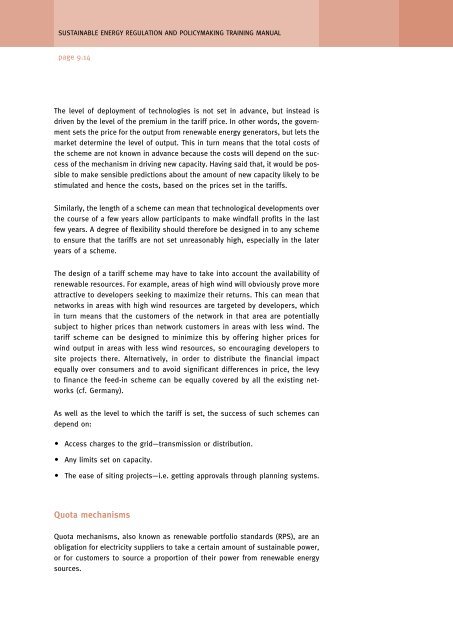Regulatory and policy options to encourage development of ...
Regulatory and policy options to encourage development of ...
Regulatory and policy options to encourage development of ...
- No tags were found...
Create successful ePaper yourself
Turn your PDF publications into a flip-book with our unique Google optimized e-Paper software.
SUSTAINABLE ENERGY REGULATION AND POLICYMAKING TRAINING MANUALpage 9.14The level <strong>of</strong> deployment <strong>of</strong> technologies is not set in advance, but instead isdriven by the level <strong>of</strong> the premium in the tariff price. In other words, the governmentsets the price for the output from renewable energy genera<strong>to</strong>rs, but lets themarket determine the level <strong>of</strong> output. This in turn means that the <strong>to</strong>tal costs <strong>of</strong>the scheme are not known in advance because the costs will depend on the success<strong>of</strong> the mechanism in driving new capacity. Having said that, it would be possible<strong>to</strong> make sensible predictions about the amount <strong>of</strong> new capacity likely <strong>to</strong> bestimulated <strong>and</strong> hence the costs, based on the prices set in the tariffs.Similarly, the length <strong>of</strong> a scheme can mean that technological <strong>development</strong>s overthe course <strong>of</strong> a few years allow participants <strong>to</strong> make windfall pr<strong>of</strong>its in the lastfew years. A degree <strong>of</strong> flexibility should therefore be designed in <strong>to</strong> any scheme<strong>to</strong> ensure that the tariffs are not set unreasonably high, especially in the lateryears <strong>of</strong> a scheme.The design <strong>of</strong> a tariff scheme may have <strong>to</strong> take in<strong>to</strong> account the availability <strong>of</strong>renewable resources. For example, areas <strong>of</strong> high wind will obviously prove moreattractive <strong>to</strong> developers seeking <strong>to</strong> maximize their returns. This can mean thatnetworks in areas with high wind resources are targeted by developers, whichin turn means that the cus<strong>to</strong>mers <strong>of</strong> the network in that area are potentiallysubject <strong>to</strong> higher prices than network cus<strong>to</strong>mers in areas with less wind. Thetariff scheme can be designed <strong>to</strong> minimize this by <strong>of</strong>fering higher prices forwind output in areas with less wind resources, so encouraging developers <strong>to</strong>site projects there. Alternatively, in order <strong>to</strong> distribute the financial impactequally over consumers <strong>and</strong> <strong>to</strong> avoid significant differences in price, the levy<strong>to</strong> finance the feed-in scheme can be equally covered by all the existing networks(cf. Germany).As well as the level <strong>to</strong> which the tariff is set, the success <strong>of</strong> such schemes c<strong>and</strong>epend on: Access charges <strong>to</strong> the grid—transmission or distribution. Any limits set on capacity. The ease <strong>of</strong> siting projects—i.e. getting approvals through planning systems.Quota mechanismsQuota mechanisms, also known as renewable portfolio st<strong>and</strong>ards (RPS), are anobligation for electricity suppliers <strong>to</strong> take a certain amount <strong>of</strong> sustainable power,or for cus<strong>to</strong>mers <strong>to</strong> source a proportion <strong>of</strong> their power from renewable energysources.










